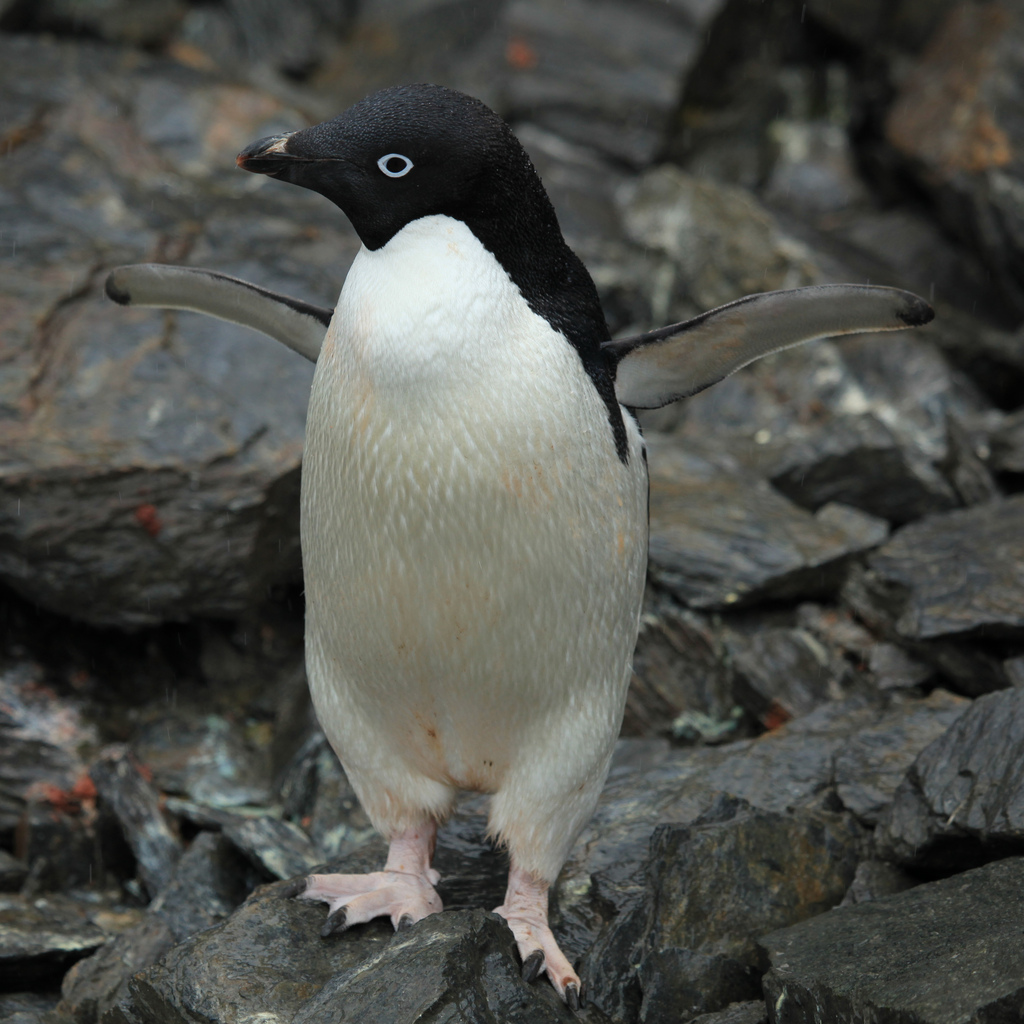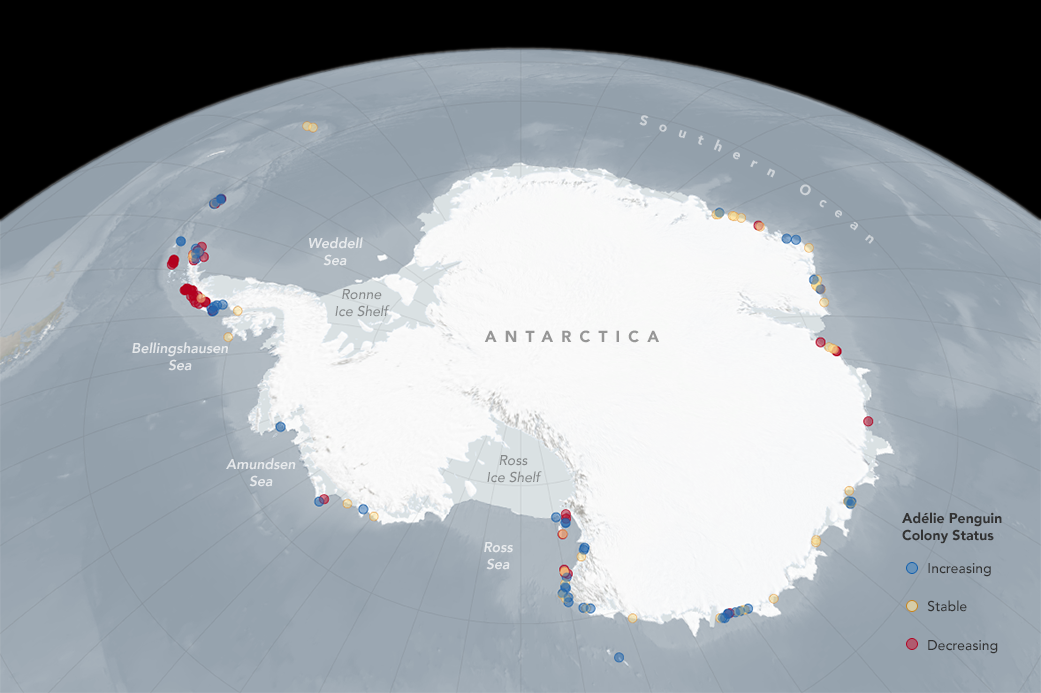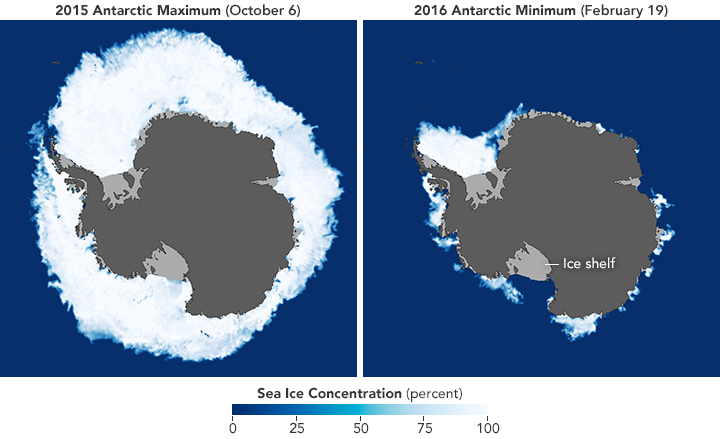Climate Change
4.4 Climate Change Effects Migration Patterns of Adelie Penguins
Melissa L. Dick
Adélie Penguins are being forced to migrate thousands of miles in Antarctica due to climate change. Human activities are causing an effect in even these uninhabited zones. Will the increasing temperatures associated with climate change have a negative impact on the species or will these penguins continue to thrive in the Ross Sea?

The Adélie Penguin population has significantly increased in the last 50 years, but many researchers believe that this current trend may not correlate to a positive future for the species. Adélie Penguins are one of the few animals that have adapted to live in the extreme environments of Antarctica, however they are highly sensitive to the effects of climate change. Adélie Penguins were discovered in 1840 by the French explorer Jules Dumont d’Urville.3 Adélie Penguin colonies have been known to exist primarily around the Antarctic Peninsula, an 1,287 km (800 mile) long peninsula on the northern edge of the continent.3,7 For many years, the Antarctic Peninsula provided perfect living conditions for Adélie Penguins due to the large amount of sea ice that formed in this area.7,9,8,12,13
Adélie Penguins are known for their ability to dive into deeper water than most predators in the surrounding oceans. Their main food source, krill, lives under the sea ice and are easy for the penguins to reach due to their deep diving ability.13 Without sea ice, Adélie Penguins must swim further and longer to find food, have no place to rest, and krill become easily accessible to other predators in Antarctica, which causes a food shortage for Adélie Penguins.7,8
In the last 50 years, the Antarctic Peninsula’s yearly mean temperature has increased by over 2℃, making it one of the most rapidly warming regions in the Southern Hemisphere and the world.1,7,8,9 The region has also experienced a rise in the mean winter temperature, as well as, the surface ocean.8 This annual temperature increase has caused melting of sea ice, which has diminished the Adélie population on the peninsula by almost 90% in the past three decades.9 The penguin populations rely on this sea ice, an approximately 70% ice cover is ideal for the species.4 The increase in temperature and the resulting decrease in sea ice has caused the species to migrate from areas surrounding the Antarctic Peninsula to colder areas of Antarctica surrounding the Ross Sea.7,8

Unlike the Antarctic Peninsula, the Ross Sea is a part of Antarctica that has not yet seen a decrease in sea ice in recent decades.1,9 This area has not been as affected by climate change so its temperatures remain cold enough to maintain a large amount of sea ice.9,11 Surprisingly, there has been an overall upward trend in sea ice in areas around the Ross Sea, thus making it a perfect new location for Adélie Penguin populations to settle.9,11
Thousands of Adélie Penguins have been forced to migrate to areas surrounding the Ross Sea to survive.7,8 Penguins that inhabit these areas have endured extensive migrations, averaging 12,760 km (7,929 miles).4 This migration results in a change of habitat for these penguins and has led to an increase of their population.5,7,9 According to ecologist Heather Lynch at Stony Brook University in Stony Brook, New York, the Adélie Penguin population now has 3.79 million breeding pairs, which is about 1.4 million more pairs than 20 years ago.5

Now that Adélie Penguins are thriving in areas around the Ross Sea, scientists consider if climate change will start to have a negative impact on the species in these areas. Climate models are used to better to gauge future changes in penguin habitats.2 One of the most recent and accurate climate models was created by Dr. David Ainley, a Senior Ecological Associate at H.T. Harvey & Associates in San Jose, California.2 The model was named the Ensemble model, and is used to help compare current conditions in the Ross Sea to conditions projected for when the Earth’s average tropospheric temperature reaches 2ºC above preindustrial levels (around 1860).2 This model uses averages of several different models to determine when this will occur.2
The Ensemble model predicts that the Ross Sea’s overall temperature will increase in the future.2 The model indicates that the 2ºC threshold will be reached between the years 2025-2052.2 The Ensemble model also predicts a steady decrease in sea ice in the area (Figure 4).2 Once the 2ºC threshold is reached, there will be a decrease in the expanse and thickness of sea ice in the Ross Sea.2 Fortunately, the Ross Sea mean annual temperature is currently about 10ºC colder than the coast of East Antarctica, so it is projected to take hundreds of years until the Ross Sea area experiences habitat changes similar to the Antarctica Peninsula due to climate change.2
Figure 4. Although the upward trend in population, documented by several different researchers in last two decades, appears promising, it is believed that the temperatures across Antarctica will continue to rise and melt sea ice in every part of the continent.9 These habitat changes will lead to the eventual decline in penguin populations. The Ross Sea is projected to be the last place on Earth where sea ice will persist.9 As of 2012, Adélie Penguins have been considered a near threatened species.5 Due to the change in climate occurring in Antarctica, researchers such as Dr. Ainley believe that in the foreseeable future, the Adélie Penguin population will go from a near threatened species, to a status of more concern, such as vulnerable or endangered.7
It is up to humans to reduce actions that are causing climate change to aid in the survival of the Adélie Penguins. Human activities contribute to climate change by causing changes in the Earth’s atmosphere in the amounts of greenhouse gases, aerosols, and cloudiness.6,10 The largest known contribution of greenhouse gas is from the burning of fossil fuels, which releases carbon dioxide into the atmosphere.6The impact of climate change is global, even affecting Antarctica, which is mostly uninhabited by humans.10These effects are best observed by ozone depletion in Antarctica over the last few decades. Research conducted by NASA (1979-2003) and by the Royal Netherlands Meteorological Institute (2004-Present),demonstrate the ozone hole has grown from 1979-2003 (Figure 5).10 The growth of the ozone hole suggests that climate change will continue to have a major effect on Antarctica until the development of fossil fuel alternatives.6Whether through government regulations or contributions made by individual people, it is up to humans to combat climate change so that Adélie Penguins continue to thrive in the Ross Sea.
References:
- Ainley, D. (2008, July 8). Climate witness: David Ainley, Antarctica. World Wildlife Fund. Retrieved from http://wwf.panda.org/?139261/Climate-Witness-David-Ainley-Antarctica
- Ainley, D., et al. (2010). Antarctic penguin response to habitat change as Earth’s troposphere reaches 2 degrees Celsius above preindustrial levels. Ecological Monographs, 80(1):49-66.
- Australian Government – Antarctic Division. (2012, December). Adélie penguins. Retrieved from: http://www.antarctica.gov.au/about-antarctica/wildlife/animals/penguins/adelie-penguins
- Ballard, G., et al. (2010). Responding to climate change: Adélie penguins confront astronomical and ocean boundaries. Ecology, 91(7):2056-2069.
- BirdLife International. The IUCN Red List of Threatened Species. (2016, October 1). Pygoscelis adeliae. Retrieved from http://www.iucnredlist.org/details/22697758/0
- Brune, W.H., (2015). The ozone story: a model for addressing climate change? Bulletin of the Atomic Scientists. 71(1):75-85.
- Clucas, G.V., et al. (2014). A reversal of fortunes: climate changes ‘winners’ and ‘losers’ in Antarctic Peninsula penguins. Scientific Reports. 4(5024):1-7
- Ducklow, H.W., et al., (2007). Marine pelagic ecosystems: the west Antarctic Peninsula. Philosophical Transactions of the Royal Society B-Biological Studies, 362(1477):67-94.
- Isaacson, A. (2011, May 9). In a changing Antarctica, some penguins thrive as others suffer. The New York Times, pp. D3.
- Lindsay, R. Antarctic Ozone Hole. NASA Earth Observatory. Retrieved from http://earthobservatory.nasa.gov/Features/WorldOfChange/ozone.php
- Lindsay, R. (2017). Antarctic Sea Ice. NASA Earth Observatory. Retrieved from http://earthobservatory.nasa.gov/Features/WorldOfChange/sea_ice_south.php
- Lynch, H.J., et al. (2012). Spatially integrated assessment reveals widespread changes in penguin populations on the Antarctic Peninsula. Ecology, 93(6):1367-1377.
- Siegel, V., et al. (2013). Distribution and abundance of Antarctic krill (Euphausia superba) along the Antarctic Peninsula. Deep-Sea Research Part I: Oceanographic Research Papers, 77: 63-74.
Figures:
- Jahn, Reinhard. (2007). [Photograph of Adele Penguin at King Georges Island]. Modified from Wikimedia Commons. CC BY-SA 2.0. DE.
- Lindsey, Rebecca, National Oceanic and Atmospheric Administration, Earth Observatory. (2017). [Graphic of Ozone hole over time]. Retrieved from https://earthobservatory.nasa.gov/Features/WorldOfChange/ozone.php.
- National Oceanic and Atmospheric Administration, Earth Observatory. (2017). [Graphic of changes to Adelie penguin breeding areas]. Retrieved from https://www.nasa.gov/feature/goddard/2016/climate-change-may-shrink-adelie-penguin-range-by-end-of-century.
- Quinn, Liam. (2011). [Photograph of Adelie Penguin in Antarctica]. Retrieved from FlickrCommons. CC BY-SA 2.0.
- Stevens, Joshua., National Oceanic and Atmospheric Administration, Earth Observatory. (2101). [Graphic of seasonal sea ice coverage]. Retrieved from https://earthobservatory.nasa.gov/Features/SeaIce/page4.php.
